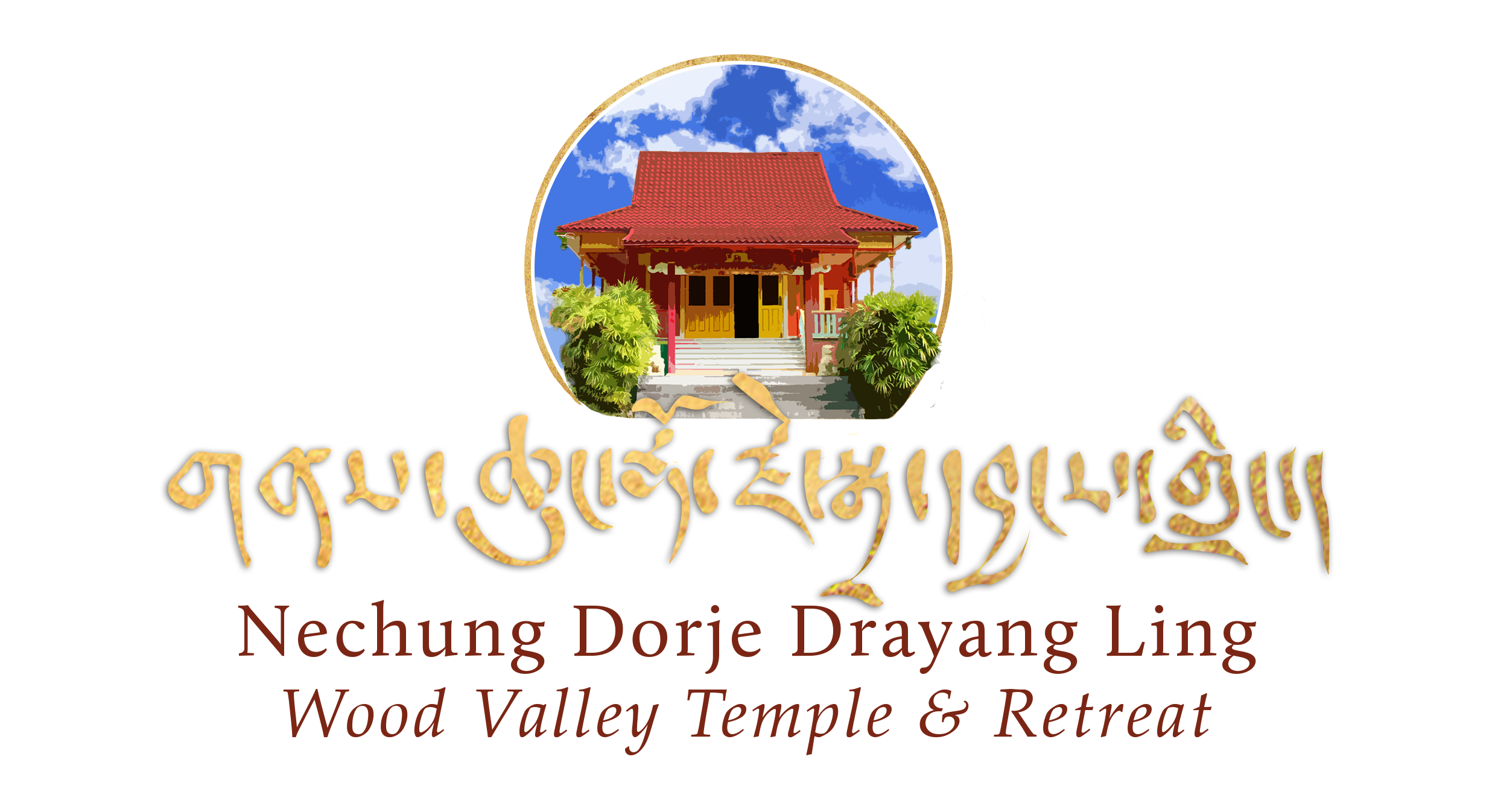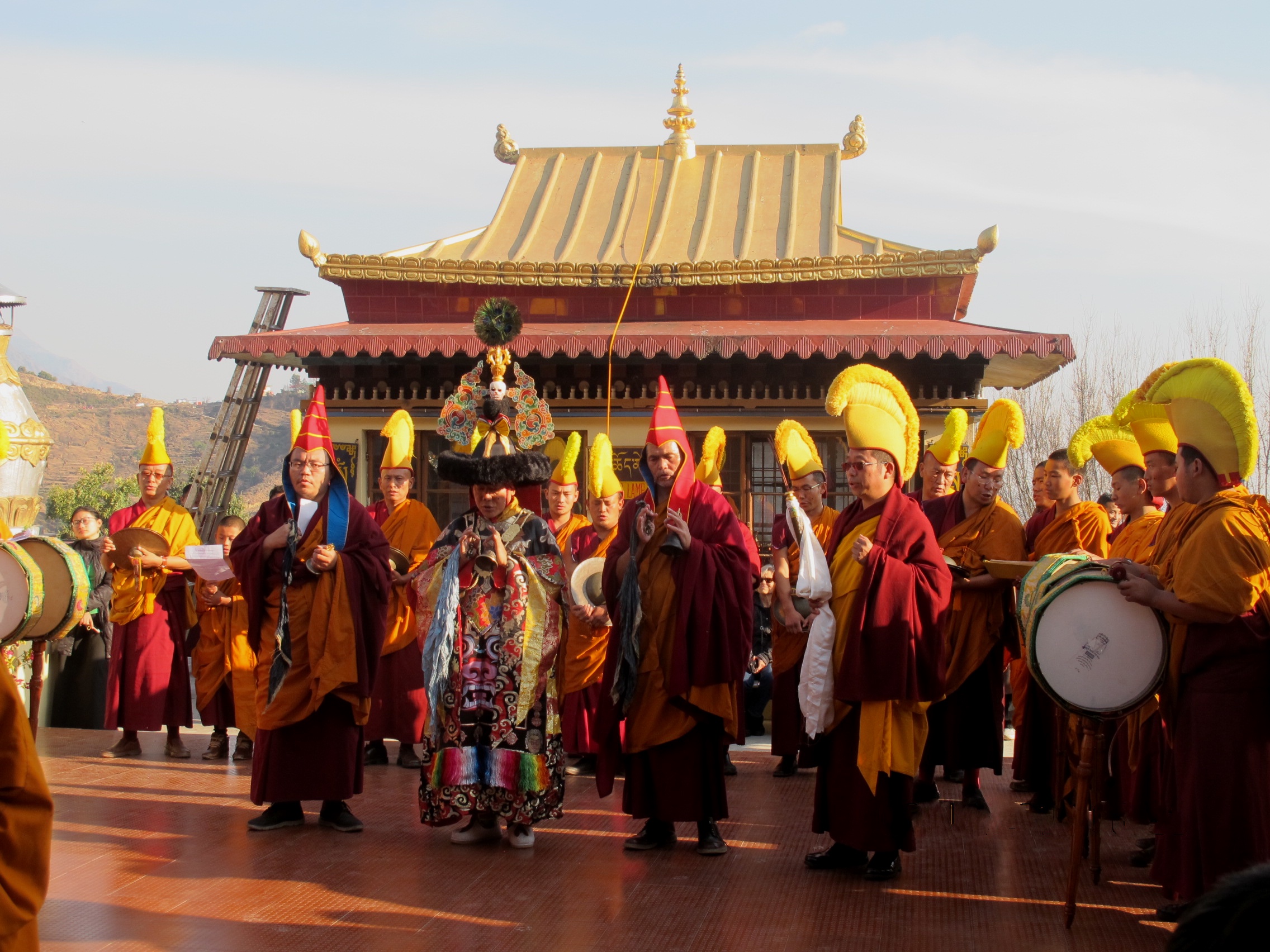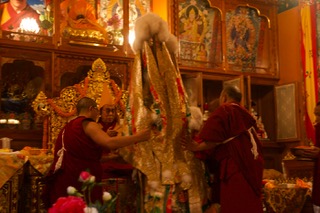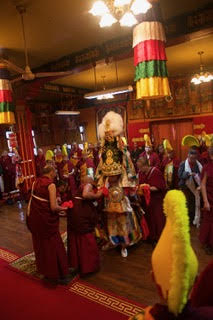ABOUT
Nechung Dorje Drayang Ling Monastery has an important role in Tibetan culture and history, dating back centuries, as the seat of Nechung, the Chief State Oracle of Tibet. Nechung Monastery still exists outside of Lhasa, Tibet, and another has been reestablished in Dharamsala, India. In America, there are centers here in Wood Valley, Hawai`i, New York, San Fransisco, and Los Angeles. Established in 1973 by the Venerable Nechung Rinpoche, Nechung Dorje Drayang Ling, in Hawai`i, is a center for the dissemination of the Buddhist teachings and continues to have close ties with the Nechung Monastery in India.
Nechung Oracle
Like many ancient civilizations of the world, the phenomenon of oracles remains an important part of Tibetan culture. Tibetans rely on oracles for various reasons. The purpose of the oracles is not just to foretell the future. They are called upon as protectors and sometimes used as healers. However, their primary function is to protect the Buddha Dharma and its practitioners. In the Tibetan tradition, the word oracle is used for an entity which enters those men and women who act as mediums between the human and the spiritual realms. The mediums are, therefore, known as kuten, which literally means, "the physical base."
In his autobiography, “Freedom in Exile”, His Holiness the Dalai Lama writes: “In former times there must have been many hundreds of oracles throughout Tibet. Few survive but the most important — those used by the Tibetan Government — still exist. Of these, the principal one is known as the Nechung oracle. Through him manifests Dorje Drakden, one of the protector divinities of the Dalai Lama.
Nechung originally came to Tibet with a descendant of the Indian sage Dharmapala, settling at a place in Central Asia called Bata Hor. During the reign of King Trisong Deutsen in the eighth century AD, he was appointed protector of Samye monastery by the Indian Tantric master and supreme spiritual guardian of Tibet, Padmasambhava. (Samye was in fact the first Buddhist monastery to be built in Tibet and was founded by another Indian scholar, the abbot Shantarakshita.) Subsequently, the second Dalai Lama developed a close relationship with Nechung — who had by this time become closely associated with Drepung monastery — and thereafter Dorje Drakden was appointed personal protector of succeeding Dalai Lamas.
For hundreds of years now, it has been traditional for the Dalai Lama, and the Government, to consult Nechung during the New Year festivals. In addition, he might well be called upon at other times if either have specific queries. I myself have dealings with him several times a year This may sound farfetched to twentieth-century western readers. Even some Tibetans, mostly those who consider themselves ‘progressive’, have misgivings about my continued use of this ancient method of intelligence gathering. But I do so for the simple reason that as I look back over the many occasions when I have asked questions of the oracle, on each one of them time has proved that his answer was correct. This is not to say that I rely solely on the oracle’s advice. I do not. I seek his opinion in the same way as I seek the opinion of my Cabinet and just as 1 seek the opinion of my own conscience. I consider the gods to be my ‘upper house’. The Kashag constitutes my lower house. Like any other leader, I consult both before making a decision on affairs of state. And sometimes, in addition to Nechung’s counsel, I also take into consideration certain prophecies.
HHDL with the Nechung Oracle
In one respect, the responsibility of Nechung and the responsibility of the Dalai Lama towards Tibet are the same, though we act in different ways. My task, that of leadership, is peaceful. His, in his capacity as protector and defender, is wrathful. However, although our functions are similar, my relationship with Nechung is that of commander to lieutenant: I never bow down to him. It is for Nechung to bow to the Dalai Lama. Yet we are very close, friends almost. When I was small, it was touching. Nechung liked me a lot and always took great care of me. For example, if he noticed that I had dressed carelessly or improperly, he would come over and rearrange my shirt, adjust my robe and so on.
But despite this sort of familiarity, Nechung has always shown respect for me. Even when his relations with the Government have deteriorated, as they did during the last few years of the Regency, he invariably responds enthusiastically whenever asked anything about me. At the same time, his replies to questions about government policy can be crushing. Sometimes he just responds with a burst of sarcastic laughter. I well remember a particular incident that occurred when I was about fourteen. Nechung was asked a question about China. Rather than answer it directly, the Kuten turned towards the East and began bending forward violently. It was frightening to watch, knowing that this movement combined with the weight of the massive helmet he wore on his head would be enough to snap his neck. He did it at least fifteen times, leaving no one in any doubt about where the danger lay.
HHDL with the Nechung Oracle at Nechung Monastery
Dealing with Nechung is by no means easy. It takes time and patience during each encounter before he will open up. He is very reserved and austere, just as you would imagine a grand old man of ancient times to be. Nor does he bother with minor matters: his interest is only in the larger issues, so it pays to frame questions accordingly. He also has definite likes and dislikes, but he does not show them very readily.
His Holiness the Dalai Lama at Nechung Monastery, in India.
Nechung has his own monastery in Dharamsala, but usually he comes to me. On formal occasions, the Kuten is dressed in an elaborate costume consisting of several layers of clothing topped by a highly ornate robe of golden silk brocade, which is covered with ancient designs in red and blue and green and yellow. On his chest he wears a circular mirror which is surrounded by clusters of turquoise and amethyst, its polished steel flashing with the Sanskrit mantra corresponding to Dorje Drakden. Before the proceedings begin, he also puts on a sort of harness, which supports four flags and three victory banners. Altogether, this outfit weighs more than seventy pounds and the medium, when not in trance, can hardly walk in it.
HHDL with the Nechung Oracle at Nechung Monastery
The ceremony begins with chanted invocations and prayers, accompanied by the urgings of horns, cymbals and drums. After a short while, the Kuten enters his trance, having been supported until then by his assistants, who now help him over to a small stool set before my throne. Then, as the first prayer cycle concludes and the second begins, his trance begins to deepen. At this point, a huge helmet is placed on his head. This item weighs approximately thirty pounds, though in former times it weighed over eighty.
Now the kuten’s face transforms, becoming rather wild before puffing up to give him an altogether strange appearance, with bulging eyes and swollen cheeks. His breathing begins to shorten and he starts to hiss violently. Then, momentarily, his respiration stops. At this point the helmet is tied in place with a knot so tight that it would undoubtedly strangle the Kuten if something very real were not happening. The possession is now complete and the mortal frame of the medium expands visibly.
Next, he leaps up with a start and, grabbing a ritual sword from one of his attendants, begins to dance with slow, dignified, yet somehow menacing, steps. He then comes in front of me and either prostrates fully or bows deeply from the waist until his helmet touches the ground before springing back up, the weight of his regalia counting for nothing. The volcanic energy of the deity can barely be contained within the earthly frailty of the kuten, who moves and gestures as if his body were made of rubber and driven by a coiled spring of enormous power.
There follows an interchange between Nechung and myself, where he makes ritual offerings to me. I then ask any personal questions I have for him. After replying, he returns to his stool and listens to questions put by members of the Government. Before giving answers to these the Kuten begins to dance again, thrashing his sword above his head. He looks like a magnificent, fierce Tibetan warrior chieftain of old.
As soon as Dorje Drakden has finished speaking, the Kuten makes a final offering before collapsing, a rigid and lifeless form, signifying the end of the possession. Simultaneously, the knot holding his helmet in place is untied in a great hurry by his assistants, who then carry him out to recover whilst the ceremony continues.
Surprising as it may seem, the oracle’s replies to questions are rarely vague. As in the case of my escape from Lhasa, he is often very specific. But I suppose that it would be difficult for any scientific investigation either to prove or disprove conclusively the validity of his pronouncements. The same would surely be true of other areas of Tibetan experience, for example the matter of tulkus. Nevertheless, I hope one day that some sort of enquiry into both phenomena will be made.”
Lamas of the Nechung Monastery
Nechung Kuten
The present Medium, Venerable Thupten Ngodup was born in Tibet on July 13, 1958 and is a descendent of a Tantric Master, Nga-dak Nyang-relwa (1136 – 1204). As a child, Thupten Ngodup was artistically gifted, and had great compassion for others. Following the Chinese invasion, he fled with his parents into exile to India by way of Bhutan.
Thupten Ngodup joined Nechung Monastery in Dharamsala as a novice monk in 1970 at the age of twelve. The monastery was being reestablished in the late sixties, and Thupten Ngodup was one of the first wave of new monks. Due to his qualities and artistic abilities, he quickly rose to the position of the Chief Ritual Assistant to the Nechung Protector while in trance.
After the passing of Lobsang Jigme, the previous Nechung Kuten, in April 1984, there was a gap of three years when there was no presence of a Medium for the Nechung Oracle. The Nechung monks and the Tibetan community requested for the rapid appearance of a new Kuten in daily prayers. On March 31, 1987, the Venerable Thupten Ngodup entered into his first spontaneous trance during Drepung Monastery’s annual offering ceremony to the Protector at Nechung Monastery in Dharamsala. He displayed signs that indicated that he may indeed by the next Nechung Kuten.
His Holiness the Dalai Lama advised Thupten Ngodup to conduct an extended retreat and engage in special meditations and rituals to ripen and stabilize his mind and abilities. On September 4, 1987, he was formally recognized to be the Medium of Nechung, the Chief Tibetan State Oracle. He was officially enthroned in 1988 as the Kuten (Medium) of Nechung, the Chief State Oracle of Tibet. The Nechung Kuten is an important figure for the Tibetan people and Tibetan culture, and holds a position of great responsibility in the Tibetan government.
Nechung Rinpoche
The Great Thirteenth Dalai Lama recognized Thupten Konchok (1917-1983) as the reincarnation of Nechung Rinpoche. This incarnate Nechung Rinpoche became a great realized master of the sutras and tantras. He also studied Tibetan literature and astro-science from a learned astrologer at Mindroling Monastery. At the request of the Tibetan Government, he taught Tibetan language at China's Minority School in Beijing for several years before returning to Lhasa. Following the Chinese occupation, he was imprisoned on two separate occasions. He ultimately escaped from Tibet and reached India in 1962. In accordance with his premonitions, Nechung Rinpoche was able to bring from Tibet, the Se-Bag Mug-Chung (Precious Mask), one of the holiest and most priceless belongings of Nechung, the great Dharma protector, and presented it to His Holiness the Dalai Lama. From December 2, 1964 to October 9, 1973, Nechung Rinpoche was a highly respected teacher at Vishesh Kendriya Vidyalaya in Janakpuri, Delhi. During this decade, he regular visits to his Nechung Monastery in Dharamsala, Himachal Pradesh. During his stays, he passed on numerous lineages of initiations, oral transmissions and commentaries on the practices unique to the traditions of Nechung.
In 1973, he established Nechung Dorje Drayang Ling, a temple and meditation center in Hawai`i for the study of Buddhist meditation and Tibetan culture. He lived in Hawai'i from 1975 until 1983, during which time, he gave teachings from the foundations of Buddhist practice to the highest levels of tantra. He performed many prayers and rituals to purify and bless the temple and grounds during his residency.
In August, 1983, Nechung Rinpoche passed away in India. In 1993, His Holiness the Dalai Lama and the Nechung Oracle formally recognized a boy born in Lhasa, Tibet as his reincarnation. In the same year, a monk from Nechung Monastery in India, and two of his predecessor’s disciples from Hawai`i found him and accompanied him safely out of Tibet to India. Rinpoche received ordination as a monk, and studied the scriptural texts and special rituals of Nechung Monastery until 2007. He then entered Mindroling Monastic College in Clement Town, India, and graduated in the spring of 2017. Rinpoche presently lives at Nechung Monastery in Dharamsala, India, and visits his temple in Wood Valley in the spring & fall annually, giving teachings on Buddhist philosophy & meditation.
HISTORY OF NECHUNG
Nechung Monastery's roots must be traced back several hundred years to understand its significance in Buddhist culture and Tibetan history. Dating back to the reign of King Trisong Deutsen and the early dissemination of Buddhism in the 8th century, the Indian saint and tantric master Guru Padmasambhava appointed Pehar Gyalpo as the protector of Samye Monastery. At that time, Samye, Tibet's first monastery, was known as Nechen (the larger place). Nechung (Ne, place and chung, small) was a shrine dedicated to Pehar west of the capital of Lhasa, with a small monastic community of eight monks. Pehar was also bound to oath by Padmasambhava as head of the hierarchy of protectors for Tibet, with Dorje Drakden as his chief emissary.
When the Great Fifth Dalai Lama, Ngawang Lobsang Gyatso (1617-1682) gained temporal power in 1642; he instituted Pehar Gyalpo as the protector of the Tibetan government, thus Nechung Monastery became the seat of Tibet's State Oracle. The principal architect of Nechung Dorje Drayang Ling (in Tibet) was the Fifth Dalai Lama. It was on his advise and guidance that the "small place" was expanded during the regency of Desi Sangye Gyatso in 1681 and completed in 1683. The Great Fifth also composed Dra-Yang-Ma (Melodic Chant), a text of self-generation practice and an invocation of the protector, which was incorporated into the monastic rites. Other specialized prayers, rituals and training of many lineages were initiated into the monastery's practices and have been preserved until the present time.
Today, Nechung Monastery in occupied Tibet has about 20 monks. Over 80 monks are being given the full training in these disciplines at the re-established monastery in India. Of the 115 monks from the original monastery in Tibet, only 8 (including the previous Kuten, Lobsang Jigme) managed to flee in 1959. Nechung Rinpoche, the reincarnate lama of the monastery, escaped in 1962. In order to be close to His Holiness the Dalai Lama, and continue the ancient traditions from Tibet, a small rented house in lower Dharamsala served as the monastery's temporary base, where novice monks were recruited and trained. In the early ‘70s, the Tibetan Government-In-Exile granted Nechung Monastery a small plot of land directly below The Tibetan Library of Works and Archives, on which a temple hall, school building, office, and teachers & monks' residences were built. Construction began in 1977 and was complete by 1984. Since then, as funds became available from patrons, improvements to existing buildings and construction of additional structures are built on the property. The latest addition is a four story kitchen & dining hall, storage rooms, monks’ quarters and visiting lamas’ apartments.
Prayers and rituals are performed daily by the monastics in the monastery’s temple hall, as well as longer ceremonies conducted throughout the year. There are also scheduled official trances when the monks invoke the presence and appearance of the Nechung Oracle.










